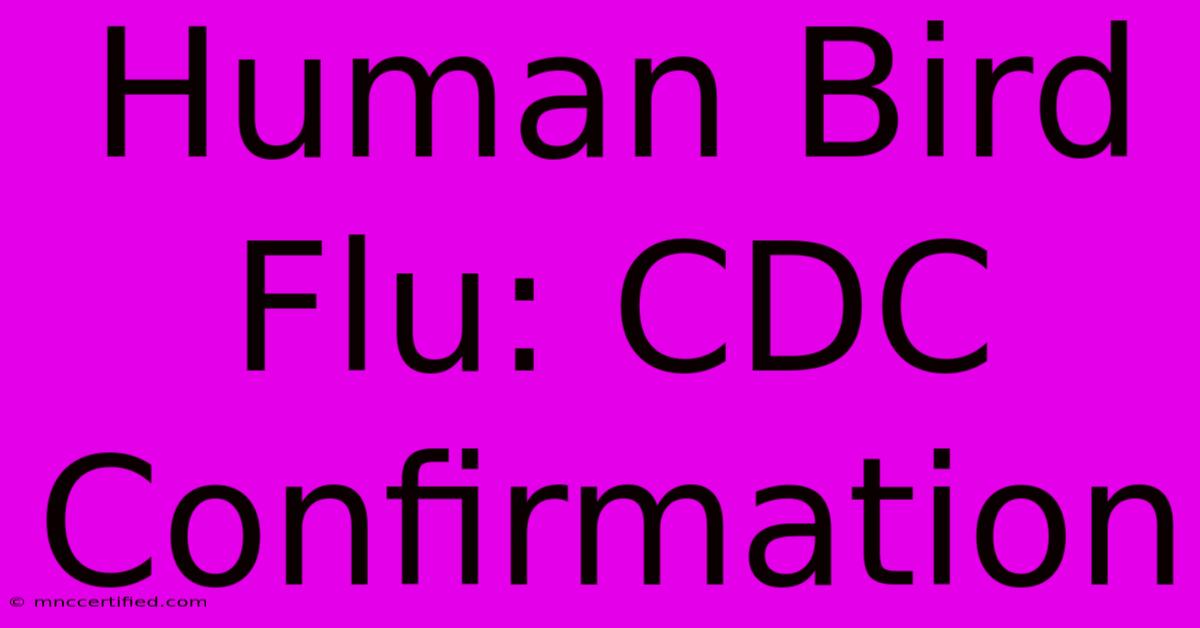Human Bird Flu: CDC Confirmation

Table of Contents
Human Bird Flu: CDC Confirmation and What You Need to Know
The Centers for Disease Control and Prevention (CDC) confirmation of human bird flu cases sparks crucial conversations about public health and preparedness. Understanding this evolving situation requires reliable information, and this article aims to provide just that, focusing on key aspects confirmed by the CDC and other authoritative sources.
Understanding Avian Influenza (Bird Flu) and its Transmission to Humans
Avian influenza, or bird flu, is caused by viruses that typically infect birds. While most strains don't affect humans, certain subtypes, like H5N1 and H7N9, have shown the ability to cross the species barrier, resulting in human infections. These zoonotic transmissions are often linked to close contact with infected birds, their droppings, or contaminated environments. The CDC emphasizes that human-to-human transmission of avian influenza is generally rare, but potential exists.
How is Human Bird Flu Contracted?
The primary risk factor for contracting human bird flu remains direct contact with infected birds or contaminated materials. This includes:
- Handling live or dead poultry: Farmers, poultry workers, and those handling birds in markets are at higher risk.
- Contact with bird droppings or secretions: Cleaning up after birds or being in close proximity to infected bird waste poses a risk.
- Preparing or consuming undercooked poultry: Although less common, eating improperly cooked poultry products can be a transmission vector.
It's crucial to understand that simple proximity to birds does not automatically equate to infection. The risk is significantly elevated through direct contact.
CDC Confirmation and Current Situation
The CDC regularly updates its website with confirmed cases, outbreaks, and related information concerning avian influenza. While specific numbers fluctuate, the CDC's confirmation of human cases underscores the importance of vigilance and preparedness. Their reports provide crucial data, including geographical locations, the specific subtype of the virus involved, and any associated fatalities. Always refer to the official CDC website for the most up-to-date information.
Symptoms of Human Bird Flu
Symptoms of human avian influenza can resemble those of regular influenza but may be more severe. These can include:
- Fever and chills: High fever is a common initial symptom.
- Cough and sore throat: Respiratory symptoms are prominent.
- Muscle aches and fatigue: Severe fatigue and body aches are typical.
- Diarrhea and vomiting: Gastrointestinal symptoms can occur in some cases.
- Pneumonia: In severe cases, pneumonia can develop.
If you experience these symptoms and have had recent contact with birds or poultry, seek immediate medical attention. Early diagnosis and treatment are crucial.
Prevention and Protective Measures
The CDC recommends several preventive measures to minimize the risk of contracting avian influenza:
- Avoid contact with live or dead birds: Do not handle wild birds, especially those appearing sick or dead.
- Practice good hygiene: Frequently wash hands with soap and water, especially after handling poultry or being in areas where birds are present.
- Cook poultry thoroughly: Ensure poultry is cooked to an internal temperature that kills the virus.
- Use personal protective equipment (PPE): If working with poultry, wear appropriate PPE, including gloves, masks, and eye protection.
- Report sick or dead birds: If you encounter sick or dead wild birds, contact your local health authorities.
Staying Informed and Seeking Reliable Sources
The constantly evolving nature of avian influenza necessitates staying informed. Rely on reputable sources like the CDC website, WHO (World Health Organization), and your local health department for accurate and up-to-date information. Avoid misinformation spread through unreliable channels.
Conclusion: Proactive Measures for Public Health
The CDC confirmation of human bird flu cases highlights the ongoing need for public health vigilance. By understanding the transmission routes, symptoms, and preventive measures, individuals and communities can play a crucial role in mitigating the risk. Staying informed through reputable sources and practicing responsible hygiene are key steps in protecting ourselves and our communities from this evolving threat. Remember, early detection and swift medical intervention are vital in managing avian influenza cases.

Thank you for visiting our website wich cover about Human Bird Flu: CDC Confirmation. We hope the information provided has been useful to you. Feel free to contact us if you have any questions or need further assistance. See you next time and dont miss to bookmark.
Featured Posts
-
Slower Rate Cuts Expected In 2025
Dec 19, 2024
-
Jan 6 Report Cheneys Fallout
Dec 19, 2024
-
The Simpsons Channel 4 Departure 2025
Dec 19, 2024
-
Rodmans Daughter Unfiltered Interview
Dec 19, 2024
-
Arsenal Vs Crystal Palace Live Match Blog
Dec 19, 2024